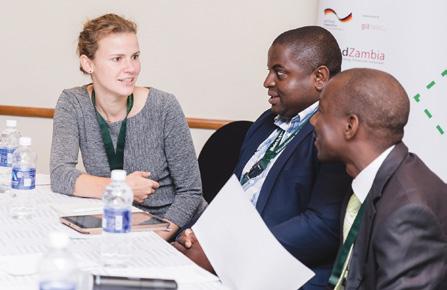
5 minute read
Parallel session 11 Reaching smallholder farmers through contract farming
Hosted by GIZ
By Kay Tuschen This session hosted by GIZ presented the business model of contract farming as a potential distribution channel for inclusive insurance. A role play demonstrated the business model pitfalls as well as advantages. Participants concluded that contract farming has great potential of mutual benefits for farmers, insurance providers, aggregators and agribusinesses.
Advertisement
Contract farming for smallholders typically involves an agricultural services firm (engaged in processing, marketing, even financial products) which agrees to supply inputs and provide technical and other assistance to them in return for the production and sale of an agricultural product at a specified price and time exclusively to the firm. The farmer commits to providing the commodity of a quality and in quantities set by the firm, and the firm commits to supporting the production and buying the commodity. Farmers benefit from an assured market and easy access to inputs, resources and services, while the firm benefits from an assured supply for processing or for sale further along the value chain. But there are pitfalls for both: the firm may not buy the product at the expected price or in the agreed quantity; and the farmer may side-sell to another buyer or use the supplied inputs for purposes other than those intended.
According to the UN’s Food and Agriculture Organisation (FAO), many governments and donors promote contract farming as part of agricultural development policies. However, there is a lingering concern about whether smaller farmers can benefit from these arrangements. Add-on financial services, such as credit and insurance, help offset many of the disadvantages while benefiting farmers as well as the contracting firm. From that perspective, contract farming follows the approach of product bundling and extends it. Farmers who buy inputs from agribusinesses also get the offer to either take up a loan and/or buy insurance against crop losses. Insurance premiums are either low or prepaid by the aggregator. In return, farmers sign up to only selling their product to the company or union that has offered the bundle. In this model, insurance providers partner up with the aggregator. A win-win contract for cotton producers and agribusiness In Zambia, more than half the working population is employed in agricultural production. Cotton is an important line of the sector. Heavy weather events such as irregular, insufficient and excessive rainfall, and droughts, lead to high annual crop losses across the whole market.
Many farmers produce on areas smaller than 5 hectares in size, and have a small collateral and low resilience to any kind of risk. Indexbased weather insurance has become an important means of protecting them against crop losses.
71 — Agrotosh Mookerjee, Managing Director, Risk Shield Ltd., Zambia (right) 72 — Left to right: Saskia Kuhn, Advisor, GIZ, Germany; Joseph Saiti, Intervention Manager, Malawi Oilseeds Sector Transformation, Malawi; Milimo Mdimba, Operations Manager, NWK AgriServices, Zambia
71

Weather Index Insurance, NWK Agri-Services, Zambia Number of people insured: 52,000
Insured risks: Drought, excess rainfall, funeral With assistance from GIZ, NWK AgriServices is offering weather-index insurance in an innovative contract farming framework. The insurance, based on satellite data, covers dry spells, droughts and excess rainfall, and is supplemented with funeral insurance. Farmers get the insurance offered in a bundle with seeds and fertilisers they need for production. NWK pre-finances the bundle and in return farmers agree to sell their yields to NWK at the end of the season. Sales revenues and potential insurance payouts are used to offset the outstanding loans and any surpluses are handed over to farmers. NWK also benefits from the offer as it has reduced side-selling. In the 2015/16 season, 52,000 of around 70,000 small farmers in the targeted region decided to buy this bundle. Out of this group, 23,000 farmers received payouts totalling more than US$ 200,000 in 2016 after a large-scale drought. Having the additional security increased investments and overall cotton production among the contracted farmers. Repayment ratios of input credits increased by up to 20 percent (see Figure 33).
Figure 33 Credit repayment rates for the insured and non-insured in selected locations in Zambia Insurance seems to incentivise farmers to repay their input credits (NWK 2013/14 data)
100 % 90 %
70 % 75 %
63 % 75 %
65 % 86 % 80 % 88 % 84 %
79 % 76 % 77 % 74 % 99 %
90 %
0 % Monze Petauke Chipata Kabwe Choma Lundazi Katete Mumbwa
Insured sheds Non-insured sheds
How to make contract farming work The agribusiness contract farming model for smallholder cotton producers is being replicated in other sectors in Zambia and in Zimbabwe. And GIZ says it can be replicated by other contract farming operators around the world.
A well-functioning contract farming framework can lead to benefits for all partners involved. This is the key factor for success: Contract farming only makes sense when there are benefits for everyone – farmers, contractors, insurers and agribusinesses. Quick claim handling is also an important means to building trust and recognition amongst farming communities. For them, the step from understanding a rather simple funeral claim to a complex index-triggered weather insurance claim is a huge leap. Nevertheless, having funeral claims paid successfully and seeing how it works for the neighbours is a big help in overcoming obstacles to buying more complex policies. Setting the right incentives helps a lot in increasing take-up rates. A challenge often faced for microinsurance products is overcoming the take-up plunge after moving from premiumfree products to paid policies. Very often, farmers did not realise their benefits in the free model, mostly because they were not aware they were insured. To overcome this, having well-handled claims visible in the communities has proven to be a good measure. There are benefits for insurers too. They create a whole new distribution channel with low operational costs along with better opportunities to acquire new data on customers. Using the network of agribusinesses also facilitates monitoring, which results in a decrease of credit risk.
Mutual benefits make contract farming a sustainable business model when targeting smallholder producers with inclusive insurance: farmers benefit from insurance as they feel secure to take the risk of entering into a cash crop delivery contract and investing in their businesses; the contract farming operator benefits through lower side-selling, higher crop deliveries and a stronger loyalty of farmers; and the insurer is able to reach customers in remote areas it would normally not be able to serve because of high logistical costs. Lessons learnt
• Contract farming is a business model that bundles the supply of inputs with credit and insurance products, as well as a binding purchase contract for the harvested crops. • Contract farming can benefit agribusinesses, MFIs and insurance providers, as well as smallholder farmers.
• Experiencing claims and successful claim handling in their communities encourages farmers to buy insurance products. • Financial literacy and awareness campaigns are important in ensuring farmers understand their commitments and potential benefits.










